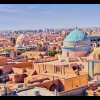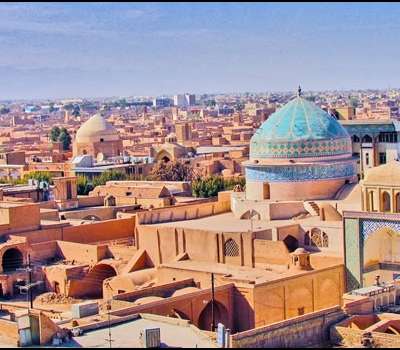
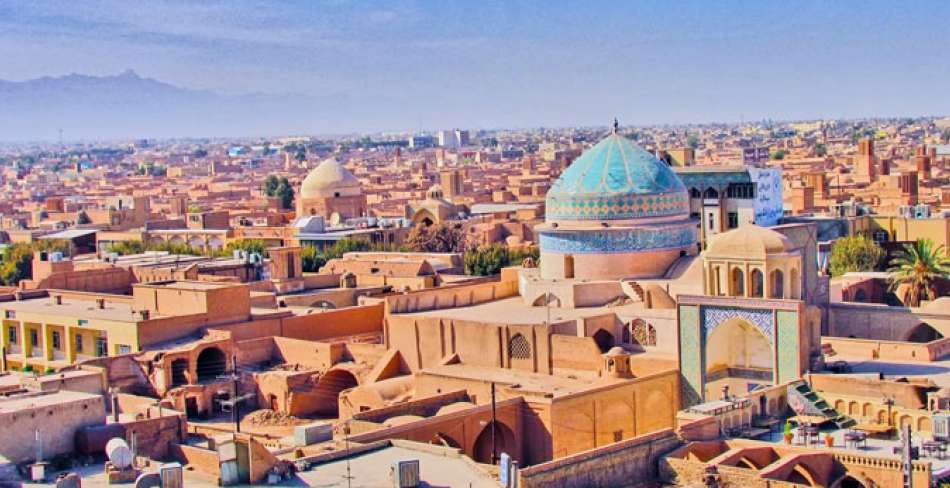
Old City of Yazd
Yazd is a historic city with a long originality and is dubbed the first adobe city and the second most historic city in the world. Attractions of Yazd demonstrate the magnificent history of the city. Before the arrival of Alexander, the Great to Iran, Yazd was a highly important region in terms of transport, military and commerce. The city grew wider and boomed once again in the time of Muzaffarids. That was the era of creating beautiful monuments, large schools, glorious mosques, original urban architecture and historic and spectacular places of Yazd.
In this article, you will read about the best and the most popular places in Yazd.
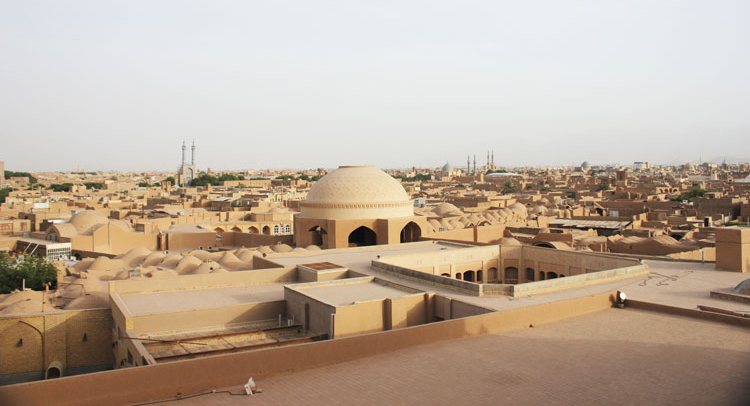
Jame Mosque of Yazd
One of the most important and most popular attractions in Yazd is the Jame Mosque. This mosque is a masterpiece from 9th century (AH) architecture with an area of 10,000 square meters. The present from of the mosque is a combination of three old mosques from different periods (less steep dome, high façade, and magnificent tilework) remained from the Qajar period. Masjed Jameh Yazd has seven doors, 2 different minarets with a height of 52 meters and a diameter of 8 meters, which was once depicted on the back of the 200-rial paper notes. The spectacular parts of Jame Mosque of Yazd include: 17-meter dome between 2 Shabestans, the ceiling of the iwan adorned with 99 names of the God in Kufi, a marble minbar built from sacred soil and rose water, a special raised platform for the worshipers in the middle of the mosque's grand courtyard, as well as inscribed stones and tiles containing endowments, the governors’ orders and commands.
To know more about this beautiful mosque, click here.
.jpg)
Dolat Abad Garden
Dolat Abad Garden is one of the most charming places in Yazd. Dolat Abad Garden with an area of 70,000 square meters, dating back to the Afsharid era around 1160 AH (18th century AD). The late Muhammad Taqi Khan, known as Khan, built a 65-km-long qanat and built the monument after transferring water of Mehriz Qanat to the current place of the Dolat Abad Garden. Dolat Abad Garden in Yazd, which has been a place for residence of Karim Khan Zand for a while, is one of 9 Persian Gardens registered in UNESCO world heritage site in 1930. This garden inludes the world highest adobe badgir with a height of 33.8 m, two summer houses (Shahneshin) and a magnificent winter house (mirror hall) with colorful windows and doors.
To read more and see more photos of Dolatabad Garden, click here.
.jpg)
Mirror and Lighting Museum in Yazd (Mirror Palace)
Yazd Mirror and Lighting Museum is the only exclusive lighting museum in Iran with an area of 837 sq. meters, which belongs to the first Pahlavi era, 1941. This complex which was built on the order of Mr. Sarrafzadeh is located in an enormous garden with an area of 8174 sq. meters including a gallery (photography, painting, calligraphy, etc.), and the rooms plastered with paintings and mirrors. Mirror Museum of Yazd has 124 objects falling into 6 following categories:
Fat-burner lightings (pivot, pendant, pedestal and lanterns), candle-burners, oil burners, gas burners, electric lights, and mirror collection along with ancient artifacts and match collection. Additionally, the museum displays calligraphic items, manuscript books, stamps, coins, weapons, locks (from the second millennium BC) and examples of bronze items from Lorestan and etc.
Read more about Mirror and Lighting Museum here.
.jpg)
Alexander's Prison (Ziaieh School)
Passing through the historical alleyways of Fahadan neighborhood in Yazd, we can see the building of the Alexander's Prison or Ziaiyeh School of Yazd with an 18-meter dome which is decorated with stucco and beautiful golden and azure decorations. The entrance door of the building is very short, but the courtyard and the building itself are very impressive bearing the Islamic architecture of the Mongols period. In 631 AH; Seyed Ziaeddin Hossein Razi, Seyed Rokn Addin Muhammad’s son in law and the founder of the Rokniyeh School designed this great school with 2 high minarets, an iwan and a large porch with numerous chambers. In the middle of this school, he also built a Payab with the depth of 5 meters and 38 steps. Ziaeddin also built a library for clergymen, and several houses with high badgirs behind the school. For centuries, Yazd has been known as the Alexander's Prison, a prison which has never been existed and in fact it has been a school called Ziaiyeh. Alexander's Prison or Ziayeh School was registered on March 13, 1967 with the registration number 770 as one of the National Monuments of Iran.
.jpg)
Fire Temple of Yazd ( Bahram Atashkade )
It is not possible to travel to Yazd, but not to visit the Fire Temple. The Zoroastrian Ateshkade in Yazd dates back to 1924, contemporary to the first Pahlavi era. It was built influenced by the Parsi Fire Temple in India locating inside a garden and near the water. This fire temple was built by Zoroastrians in Yazd and Parsi in India. The symbol of Faravahar made from blue tiles at the top front of the building is the first part that attracts every one’s attention. Then the big round pond is in the center of courtyard covered with visitors’ coins is the second part to catch eyes. The most important part of the Fire Temple is a 1500-year-old sacred fire inside a large bronze bowl inside the glass compartment of the building that is kept away from sunlight. The special prayer rooms decorated with Zoroaster’s images and Avesta quotes surround the sacred fire.
.jpg)
Amir Chakhmaq Complex of Yazd
Amir Chakhmaq complex is the symbol of Yazd. Seyed Jalaluddin Shami known as Amir Chakhmaq, the generous ruler of Yazd during the Timurid era in the 9th century AH, commanded the construction of Amir Chmakhmaq Square. However, the monument did not complete while he was alive and after his death, his wise wife, Sati Fatimah, completed the square and the water reservoir. The Amir Chakhmaq Complex consists of a mosque, a square, a bazaar and three water reservoirs. The 2-floor brick Tekye, along with 2 long minarets and many booths was added to the complex in Qajar era which lies on one side of Amir Chakhmaq Square. Amir Chakhmagh Tekye, which was once a place for gathering kings and royal ladies to watch the mourning ceremonies and Nakhl bardari (a Nakhl with 8.5 meters height dating back to 1229 AH) is 140 years old.
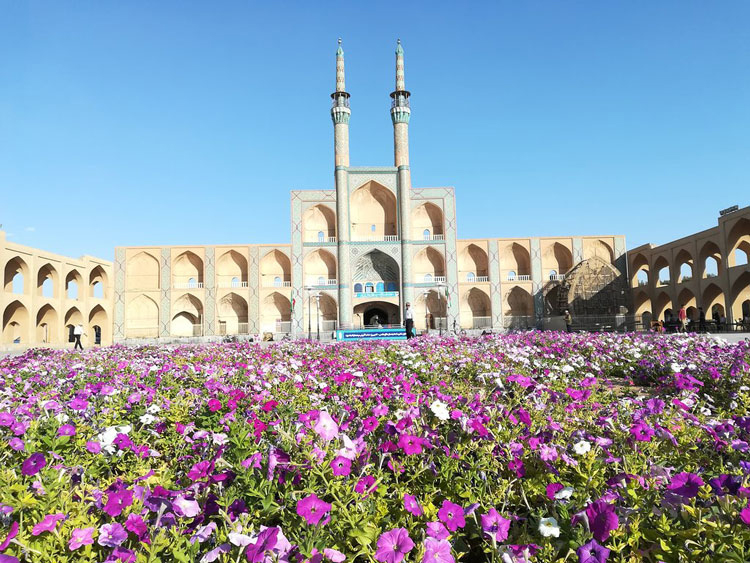
To read more about different parts of Amir Chakhmaq Square , click here.
Zoroastrian Tower of Silence
Mount Dakhme, a famous cemetery of Zoroastrians (leaving dead bodies there to be eaten by vultures) is one of the tourist attractions in Yazd, which is actually consisted of two old stone buildings (Maneckji Hataria and Golestan) which are round hallow towers. The inner surface of the towers is a flat area with three parts: masculine, feminine, and childish. In these parts, dead bodies were placed and left for six months to one year until the skin and flesh of the corpses were eaten by wild birds and bones were completely dried under the sunshine. Zoroastrians believe that this process will remove the pollutions from the body. Then the bones were poured into a central well to decompose. In the case of the mourning ceremony, the Zoroastrians mourned for three days wearing a white covering in the ruined buildings beside the Dakhme known as Kheilah.
.jpg)
Art House
On a visit to Yazd, make sure to go to the roof of Yazd Art House. The building of Art House of Yazd belonged to the Qajar era, which started to be repaired and restored in 2014. Art House which is still under reconstruction, is owned by Mehdi Malekzadeh. A small part of this monument functions as a tourism complex including a beautiful art gallery and a charming café. The roof of the house is famous for its great view to old city of Yazd, especially the magnificent view of famous desert sunset in Yazd. The Art House was registered on December 28, 2000 with the registration number 2950 as an Iranian National Monument.
Click here to go to the Yazd Art House page.
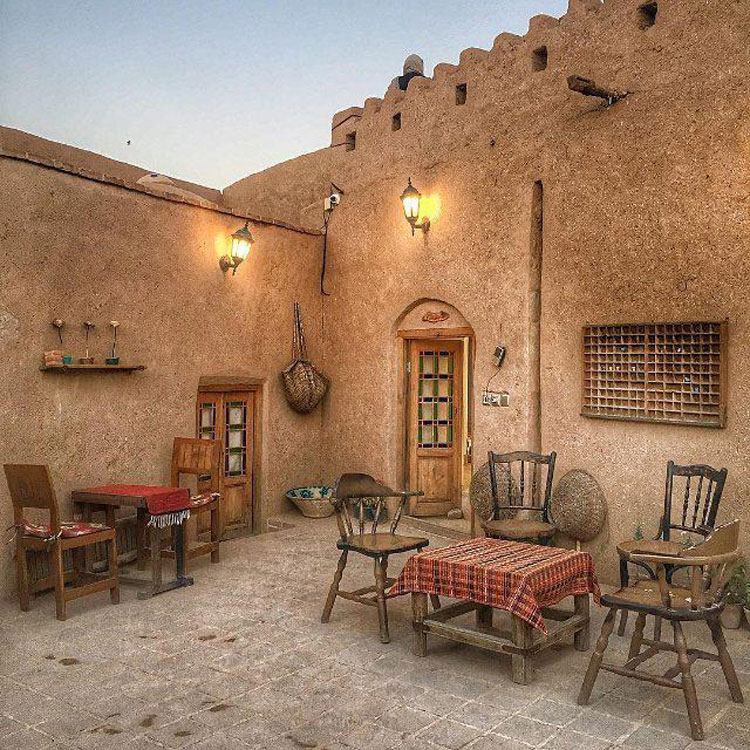
Raadina Travels offers a one-day Yazd tour to visit the attractions mentioned above to enjoy a trip with an experienced tour guide.













.jpg)
.jpg)
.jpg)
.jpg)
.jpg)

.jpg)

